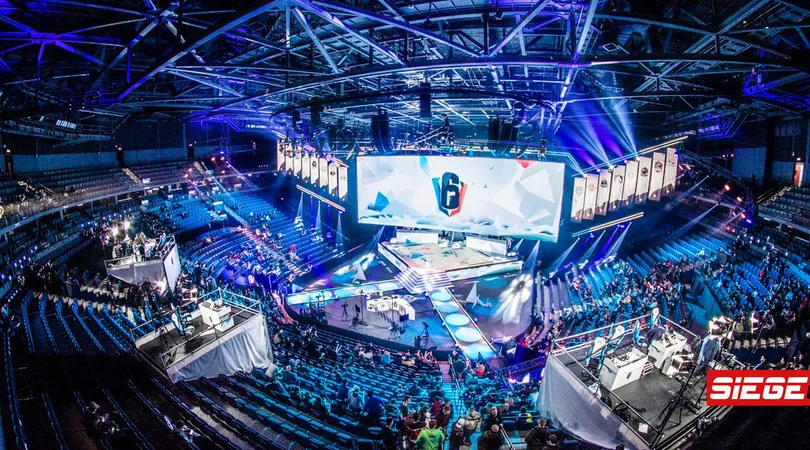
Ubisoft revealed a long-rumoured reorganization of the competitive Rainbow Six landscape today. The changes will feature BLAST taking over tournament organization and brodcasts, a total of nine regions, and two two-phase Majors.
The new format will not be franchised, but it will feature closed leagues that are balanced with a clear open path to professional play. This follows after relegation was eliminated from all top-flight leagues in the 2022 season.
New competitive calendar and Major format
![[R6SE] Unveiling the new R6 Esports Global Circuit - Timeline](https://staticctf.akamaized.net/J3yJr34U2pZ2Ieem48Dwy9uqj5PNUQTn/nhEV1HC8qosdY5Gknicmk/3c0b412e513c328e993e9fc13e0a7ae1/R6Esports_timeline_season.png)
The new competitive calendar will see a reduction in Majors to just two per year, but these will now be
Majors will now run for two weeks and will feature two phases, with Phase 1 being a "play-in" phase into Phase 2. Phase 2 will feature a total of 16 teams and will have the group stage and playoff stage like current Majors.
Stage 1 will run from March to April and will end with a Major in May, before there will be a three-month off-season from June to August.
Stage 2 will then run from September to October and will end with a Major in November before a two-month off-season.
According to Ubisoft, the longer off-seasons will "give more time for teams to regroup, rest and prepare" -- likely in response to multiple teams feeling overworked in the current, tightly-packed format. Due to this burnout, teams like Soniqs have struggled in the subsequent stages, while teams like DarkZero Esports and Rogue have failed to even qualify to the next Major despite being defending champions.
The longer off-seasons will also be "creating room for third-party tournaments".
The Six Invitational will continue to be held in February, marking the end of the season and featuring the reveal of the upcoming year of regular and competitive Rainbow Six. The flagship world championship event, though, will no longer have last-chance qualifiers as it currently does.
All 20 teams at SI 2024 onwards will be determined through the Global SI Points standings, with that event also to be held at a "warmer" locale than Montreal in Winter. The SI Points will also bias more towards international performances, rather than regional performances.
Ubisoft also revealed in an accompanying blog article that BLAST will be taking over tournaments and broadcasts for Rainbow Six Siege from ESL and FACEIT in a "multi-year" deal. This will include the Six Invitational, but exclude the Japan region, which will be continue to be run by X-MOMENT.
New regions
The new format will feature a total of nine regions. Some of these regions are currently categorized as sub-regions, a few are intact, while one is entirely new.
![[R6SE] Unveiling the new R6 Esports Global Circuit - Regions](https://staticctf.akamaized.net/J3yJr34U2pZ2Ieem48Dwy9uqj5PNUQTn/5NO4l9ntRxgOsNWxJuQYce/7f8f9e2785f6f426ceecc19c8e3e78cd/R6Esports_regions.png)
- North America
- Brazil
- Europe
- Korea
- Japan
- Hispanic Latin America (LATAM)
- Asia
- Oceania
- Middle East and North Africa (MENA)
Each region will also have direct opportunities to play at the Majors and will feature a "path to pro" despite the closed nature of the leagues, with every league having eliminated the opportunity of promotion and risk of relegation in 2022.
With the new system, only NA and EU will be intact as regions with no changes. Meanwhile, Brazil will finally be freed from being pigeon-holed into the LATAM region and will no longer feature a tournament like the Copa Elite Six. Instead, it will be an on-par region with 10 teams in the BR6 (like in NA and EU), and not a LATAM sub-region.
The current APAC North region is then split into two different regions, Korea and Japan. Of these, Japan will also feature "up to" 10 teams like in NA, EU, and BR, while Korea will feature "up to" eight teams.
The current Campeonato Sudamericano and Campeonato Mexicano in 2022 have also been combined into a Hispanic LATAM league with "up to" eight teams for 2023.
The "Asia" region will not have any relation to the East Asian regions of Korea and Japan, but will instead see the sub-regions of Southeast Asia and South Asia classified under one region.
The Oceanic region, on the other hand, has been split off from the current APAC South Division.
Finally, there will be the official inclusion of the all-new MENA region that has so far been running various community leagues and most recently hosted the big-money Gamers8 event.
Further details for Asia, MENA, and Oceania were not revealed.
Further details
Ubisoft only revealed the above information today, with a promise to reveal more information next year at the Six Invitational 2023.
SiegeGG is supported by its audience. When you purchase through links on our site, we may earn an affiliate commission. Learn more about how readers support SiegeGG.